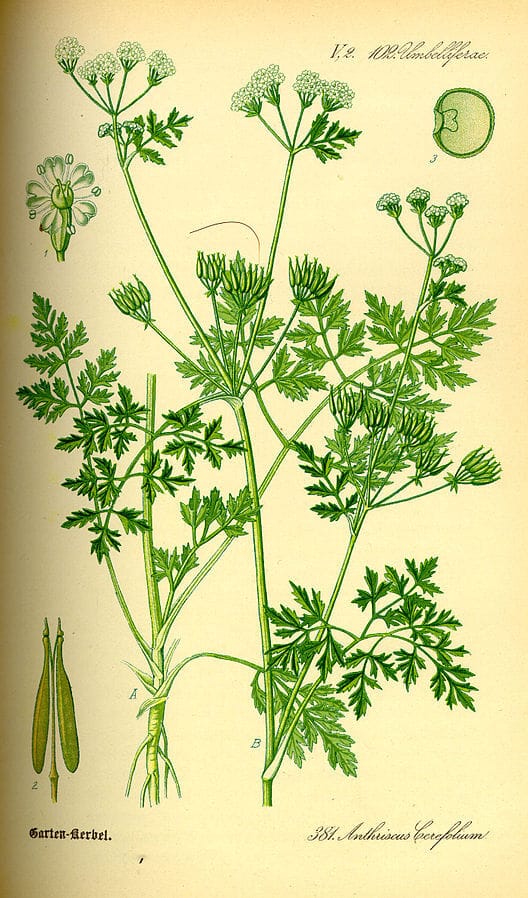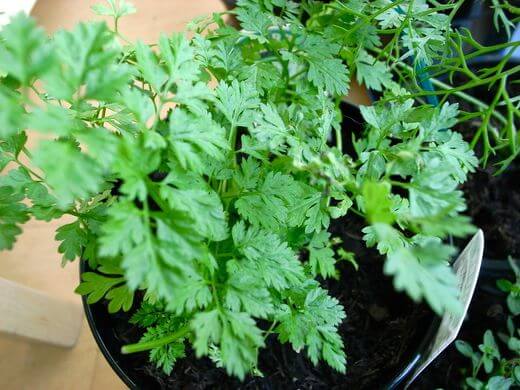Sometimes also called French parsley, chervil (Anthriscus cerefolium) is a mild herb that plays an important role in French and Mediterranean cuisines. This annual plant is native to Europe. This herb is closely related to parsley and the two herbs look very similar. But, chervil leaves tend to be smaller, frillier, and paler in color compared to parsley leaves.

(Photo by: Otto Wilhelm Thomé/Wikimedia Commons)
Edibility and culinary use
Chervil has light taste and aroma that’s reminiscent of anise or tarragon. Both fresh and dried chervil leaves can be used to enhance the flavor of a dish. However, dried chervil has a weaker taste. Overheating the leaves can also weaken their taste, so it’s actually better to add them to a dish at the end of the cooking process or after it’s done cooking. They pair wonderfully with chicken, fish, and egg dishes. They can also be used to enhance the taste of soups, creamy sauces, and oil-based salad dressings.
People mainly only use chervil leaves for cooking, but its flowers and seeds are edible as well. Much like the leaves, chervil flowers and seeds also have a delicate, anise-like flavor. They can be as a substitute for chervil leaves in recipes. Lastly, the leaves and flowers can be made into juice or tea. Many societies throughout history have been using these herbal drinks for medicinal purposes.
Health benefits
Chervil has been an important part of folk herbal medicine since the Ancient Roman period. This herb is a great source of vitamin A and C. This means consuming chervil can greatly benefit your vision and immune system. It also contains important minerals such as calcium, selenium, potassium, and copper which will help you stay healthy.
Chervil tea and juice are especially good to use as a herbal medicine due to their potency. These drinks can help treat different ailments, such as high blood pressure, high cholesterol, digestive problems, constipation, cough, gum diseases, mouth ulcers, and fluid retention. Additionally, it can also relieve menstrual cramps and abdominal pain.

(Photo by: The Croft/Flickr)
You can also apply the tea topically to aid certain skin ailments and maintain skin health. Dabbing it on insect bites and eczema will make them heal faster as well as reduce the itchiness. Adding tea in your skincare routine can also reduce wrinkles, improve the skin’s elasticity, and aid any skin inflammations.
Cultivation
In addition to having wonderful culinary and medicinal benefits, it’s also a great companion plant for carrots, lettuces, and radishes. Cultivating chervil nearby will enhance the quality of the two other plants. It can also help repel harmful insects and protect other plants. Lastly, if you’re tight on space, this plant can grow well in containers, allowing you to put them in your kitchen’s tiny herb garden.
Unlike other herbs, chervil actually prefers cooler temperature and sheltered locations. It also needs to be kept moist all the time. Water them often but be careful to not flood the soil. It should also be noted that chervil has really long roots that don’t respond well to moving and crowding. So, keep that in mind while sowing the seeds.
The seeds can be sown in the spring or fall. You can also sow them in a successive pattern every 2 or 3 weeks up until 6 weeks before the starting frost date. Doing this will ensure you have a constant supply of chervil to use. Sow the seeds in groups of five and plant them just below the soil. Give 1’ space in between each group to avoid overcrowding. They’ll be ready for harvest in 6 or 8 weeks after sowing.

(Photo by: Kurt Stüber/Wikimedia Commons)
Be sure to only harvest the young leaves and avoid mature leaves that have turned purple or flowered. Older leaves lose their sweetness and taste bitter instead. Cut the leaves at the base to encourage more growth. Harvest the leaves early in the morning for the best taste.
Cautions
Chervil is generally safe to consume in normal amounts. But it should be avoided during pregnancy. Chervil contains a compound that can trigger mutations in the genes of the developing fetus and thus, cause birth and growth defects.
Conclusion
Chervil is a very useful herb to have. It tastes great as a spice, works wonders as a natural home remedy, and serves nicely as a companion plant. This tasty and helpful plant is known globally for its properties by gardeners and scientists alike. It would not be wrong to say that chervil is an amazing herb.
---------------
Writen by Cornelia Tjandra
Cornelia is a freelance writer with a passion for bringing words to life and sharing useful information with the world. Her educational background in natural science and social issues has given her a broad base to approach various topics with ease. Learn more about her writing services on Upwork.com or contact her directly by email at cornelia.tjandra@gmail.com
Many of our readers find that subscribing to Eat The Planet is the best way to make sure they don't miss any of our valuable information about wild edibles.
See our privacy policy for more information about ads on this site






